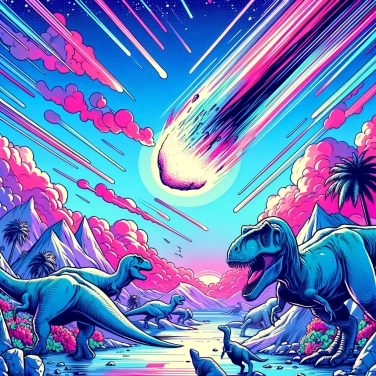The collision of a giant meteorite approximately 66 million years ago caused catastrophic environmental conditions, such as massive fires and a nuclear winter, leading to the extinction of the dinosaurs.

The main evidence of a meteorite impact causing the extinction of the dinosaurs is the existence of a thin layer of sediment rich in iridium, a metal that is extremely rare on Earth but very common in meteorites. This layer is called the K-Pg boundary, and it dates precisely to the boundary between the Cretaceous and the Paleogene (about 66 million years ago). This layer is found all around the globe, clearly indicating that the impact had planetary consequences. The massive Chicxulub crater, located in Mexico, which is about 180 kilometers in diameter, has been perfectly dated to this infamous moment. Moreover, analyses also reveal shocked quartz and glass microtektites, typical of molten rock ejected far away by a gigantic force. These combined clues leave little room for doubt about this massive past catastrophe.
When it crashed, the giant meteorite released energy equivalent to several billion atomic bombs. The initial explosion created an immense crater (the one in Chicxulub, Mexico, if you want to know). It shattered everything in the surrounding area for hundreds of kilometers, ejecting tons of burning debris into the atmosphere. The result: an immense wave of heat spread, causing major fires all over the planet. All this ejected material formed a huge cloud of dust and particles, obscuring the sun for days, even weeks. Goodbye sunny days. Add to that monstrous earthquakes, giant tsunamis sweeping the coasts, and you get a picture that’s not exactly welcoming for our poor dinosaurs.
After the meteorite impact, tons of dust and ash are thrown into the atmosphere. The result: a thick layer prevents sunlight from properly reaching the Earth. The temperature drops sharply on a global scale: this is known as an impact winter. This drastic drop in temperatures likely lasts for several years, affecting the entire food chain. Once the dust settles, the climate swings to a completely different extreme with warming related to the massive release of greenhouse gases during the impact. This abrupt and prolonged climate change deeply disrupts ecosystems. It is due to these long-term changes that many species, including dinosaurs, were unable to adapt and ultimately face extinction.
The abrupt disappearance of dinosaurs, caused directly or indirectly by the fall of a giant meteorite, released numerous ecological niches. Suddenly, previously overshadowed groups were able to thrive and diversify, such as mammals, which until then primarily lived at night, hidden under the reign of the great reptiles. The massive extinction affected about 75% of terrestrial and marine species at the time, causing a profound upheaval in the planet's biodiversity. With the enormous dinosaurs gone, smaller, adaptable, and opportunistic animals seized their chance to conquer new territories and ways of life. This major extinction thus radically transformed the evolution of life on Earth, allowing birds, direct descendants of a group of dinosaurs, as well as mammals, to gradually dominate all subsequent terrestrial ecosystems.
Today, the idea that a giant meteorite caused the extinction of the dinosaurs is widely accepted in the scientific community. This scenario is supported by very concrete discoveries, such as the identification of a layer rich in iridium, a rare element on Earth but common in meteorites. Furthermore, a massive crater buried beneath Mexico, known as the Chicxulub crater, coincides exactly with the time when the dinosaurs mysteriously disappeared. Therefore, the majority of paleontologists, geologists, and biologists endorse this hypothesis as the main explanation for the biological crisis of that era. Although there are still some debates about specific details, the meteorite impact theory remains broadly accepted and validated by the international scientific community.
The meteorite collision would have released an energy estimated to be several billion times that of a modern atomic bomb, immediately disrupting the global atmosphere.
Not all species of dinosaurs have completely disappeared: today, modern birds are considered by scientists to be direct descendants of feathered dinosaurs.
Aside from dinosaurs, about 75% of terrestrial and marine species went extinct due to the impact, thus providing an opportunity for mammals to thrive and eventually become dominant.
Recent studies suggest that if the asteroid had struck Earth just a few minutes earlier or later, it would have fallen into the deep ocean: the consequences would have been less dramatic, and the dinosaurs might have survived for a longer time.
Here is the translation: "Although a major collision with a meteorite seems unlikely in the short term, it remains scientifically possible. However, thanks to modern astronomical observation tools, we can detect such a risk in advance. Space agencies around the world continuously monitor the sky to prevent this type of threat and develop planetary defense strategies, thereby minimizing this potential risk."
No, the disappearance of the dinosaurs was not instantaneous across the entire planet. While the meteorite caused immediate colossal damage locally, the complete extinction of the dinosaurs took more time. The drastic climate changes induced by the event, such as the darkening of the sky by dust and ash, initially disrupted ecosystems, gradually leading to the disappearance of the dinosaurs in the years following the impact.
Some animals survived because they were smaller, omnivorous or insectivorous, capable of sheltering underground and consuming various food sources that were less affected by the catastrophe. In contrast, many dinosaurs, particularly large species that required a lot of food, could not adapt to these drastic ecological upheavals and quickly fell into extinction.
Before reaching the current scientific consensus, several theories had been proposed to explain the extinction of the dinosaurs. Among them were prolonged intense volcanism (the Deccan traps in India), gradual climate changes, epidemic diseases, and even biological factors such as competition with emerging species. Today, some of these hypotheses are considered aggravating factors, but the main cause remains the meteorite event.
We have numerous scientific pieces of evidence, the main one being the presence of an iridium-rich layer called the K–Pg (Cretaceous-Paleogene) layer. This element, rare on Earth but abundant in meteorites, is found all over our planet at the time of the extinction, indicating a large-scale cosmic event. Impact craters, such as the Chicxulub crater in Mexico, which dates precisely to this period, further strengthen this theory.

No one has answered this quiz yet, be the first!' :-)
Question 1/5